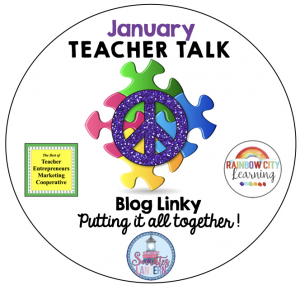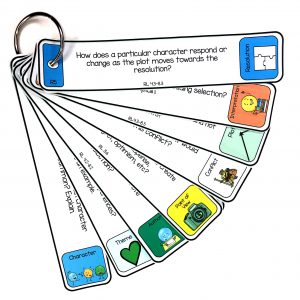Using book clubs in the classroom is one of the best additions I’ve made to my reading program. Having run book clubs for more than 15 years, I want to share 5 major benefits I’ve discovered during my experiences that have convinced me that I made the right choice.

First, book clubs provide a unique opportunity for students to read, comprehend, listen, and speak at much deeper levels, and
Second, book clubs are rigorous and engaging.
Here are the top five reasons you should consider Book Clubs in the classroom as an integral part of your reading program.
1. Deeper reading happens when using book clubs in the classroom
Students reading at a deeper level is by far the most motivating factor in my decision to use Book Clubs in my classroom. When students know they are being held accountable to other students, they are more likely to complete the reading and corresponding work. The pressure of knowing that you’ll have to talk about your reading in front of people and show your understanding is key.
The work students do to prepare for their two weekly meetings encourages them to question their reading even more. They learn why and how to “Stop and Jot” on strips of sticky notes. I ask that each student write and read aloud a summary of main events. Additionally, each student must write at least one higher-level thinking question (discussed later in this post) and complete a job which brings their own perspective to the novel. Click Here to view the comprehensive Book Club Packet with everything you’ll need.

I can tell you with certainty that when students read a novel in Book Clubs, they perform far better on comprehension tests than with their independent novels. This is especially true of struggling and middle level readers. As shocking as it may seem, there are students who enter my sixth grade classroom having never completed a novel. The Book Club format supports them through the process.
2. Book Clubs help with deeper thinking
Early in the year, I teach my students about the depth and complexity levels of questioning. I refer to the levels as
Green Questions – easy…barely need to stop to think about it…can point to the answer in the text
Yellow Questions – need to stop and consider; can find the answer by looking in several sections of the text
Red Questions – answer can’t be found in the text- you must consider it and come up with your own ideas/answers
In Book Clubs, we focus on yellow and red questions. The difference between the three levels becomes blatantly obvious when students have to discuss the answers. A student may have never asked a higher level question about a book. It’s fine to start with green because they’ll soon hear other levels of questions and notice the discussion that arises (which did not happen with the green question). Our second Book Club meeting questions are generally all at the yellow and red level unless it’s a clarifying question. Grab this Close Reading Freebie to help you add even more close reading instruction to your classroom.
For scaffolding purposes, I have leveled questions on hand to support those struggling students. The Reading Comprehension Questions are kept on hooks in my classroom throughout the year.
I often sit with a student or two and read through several different levels of questions so they can see the difference. Then I have them pick their “yellow” or “red” question from the rings for the next meeting. By the third or fourth meeting, the struggling students become more comfortable with those higher levels of questioning and, thus, higher levels of discussion. Read this blog post on supporting struggling readers during Book Clubs.
3. Book Clubs help students practice listening skills
In order to understand someone’s point of view, you must listen. Since Book Clubs are all about what the members of the group think about the novel, listening skills are essential. I teach my class basic listening skills before we start our first session of Book Clubs. Use the SLANTT acronym to help remember speaking and listening skills.
SLANTT
Sit up straight
Lean forward towards the speaker
Act like you care
Nod your head in response to the speaker
Take time to consider your opinion
Tactfully respond
We practice this as a class, and I model for them. I find it important to bring student awareness to what our minds may be doing instead of listening. We talk about training our minds to stay focused on the conversation. If something is unclear, jot it down so you can ask about it. I also teach students to
Honor confusion…
Confusion means they are thinking about the topic and recognizing that something doesn’t connect. This is part of thinking. We practice ways to ask for clarification. In fact, “When You Want Clarification” is a category on my Question Stems & Conversation Starters. It’s a freebie!
Using stems like the ones here can help clear up confusion:
“I’m not sure I understand what you are saying…”
“I need to ask for clarification on…”
“Can you repeat what you just said?”
Listening requires thinking. Teach your class how to listen and practice with them.
4. Using Book Clubs in the classroom helps students share thoughts
Speaking your thoughts is at the crux of Book Clubs. Many students have never shared their thoughts about a book. Perhaps they have never taken the time to consider what they are thinking about a novel. You know how it is when you read a novel independently. The movie runs through your head, but you may never share your perceptions and feelings about the book. In Book Clubs this sharing is essential to each meeting.
Let students know that you are observing their speaking and listening skills. Show them the standards. Admittedly, many are nervous. This is where practice helps, so we roll play. I’ve created a set of questions to generate conversation. We use these cards to help us speak and listen in a non-threatening environment.
Additionally, the Question Stems (mentioned earlier in this post) help reduce speaking anxiety. Role play a conversation about a book (ideally one you’ve read aloud to the class so they have buy-in). Project the Question Stems for all to see. Offer an observation and then have a role play partner (who may be another student that you check in with earlier to prep for this role play) and have a discussion. Point to the stem on the paper and use it. See the categories for phases of a conversation on the stem page. Note where you are in your conversation so students can see the pattern.
The first Book Club meeting is the quietest. Nerves show themselves. But after this round generally all students begin to engage, which is the entire point!
5. Book Clubs make students better independent readers
Once we finish our entire Book Club work for the novel, use the work they’ve done as a springboard for their independent reading. Students have had the experience of thinking at a much deeper level about their reading. Now this common reference point is part of their reading history.
During our independent reading work, I may ask some of the same questions that came up during Book Clubs. Students will write about their reading with more confidence. I can refer back to our lessons about focusing the mind and being aware of confusion.
One bonus from participating in Book Clubs is the positive classroom culture shift toward reading. Student interest is peaked in the novels other students were reading during our session, and they now want to read!! So, I “retire” a novel from Book Clubs for the year and it becomes a hot item for independent reading. The students who’ve read the novel have so many opinions that partner and small group discussions spontaneously crop up around independent reading. I continue to cultivate this shift by displaying our next round of novels and giving short book talks.
Most important, though, is that students have had a reading experience that connects fun, rigor, enjoyment, and the pride that is felt in completing a book.
I have everything you need to run book clubs in your classroom all done for you. It includes teacher support pages to help you succeed! I’d love to hear about your experiences using book clubs in the classroom.
Pin this blog post to a relevant board for future reference.
I’m linking up with some fabulous teacher-authors. Check out their posts as well!








Great post and so informative. Book Reading Clubs are a great way to instill a joy of reading in your students. By the way, I love your site, I could tell it’s from Laine, she did mine too.
Thanks, Deann. Book clubs are worth the effort! Can’t wait to check out your site!
I enjoyed this post about book clubs. I agree, having book clubs is truly a great way to get students to take their reading more seriously. Your tools for running book clubs are fabulous!
Thanks, Michelle. My hope is to inspire teachers who’ve either never attempted book clubs or who’ve struggled with the process.
Great post! I like your ideas. Book clubs are a fun way for students to read.
Thank you, Sally. My ideas come from my successes and my failures. I’ve had enough experience to know what works.
I love using book clubs also!! I love all your forms with structure to guide students to lead independently. Thanks, Marcy!